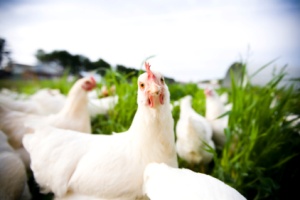 A coalition of worker safety and food safety groups is urging the FDA to drop a proposed regulation that would pull government food inspectors from poultry plants and allow companies to conduct their own inspections and speed up production lines.
A coalition of worker safety and food safety groups is urging the FDA to drop a proposed regulation that would pull government food inspectors from poultry plants and allow companies to conduct their own inspections and speed up production lines.
"I worked 30 years as an inspector for USDA's Food Safety and Inspection Service and I saw firsthand how badly the HACCP-Based Inspection Models Project (HIMP) has worked in poultry plants,” said retired FDA inspector Ken Ward, a member of the coalition. “Expanding the pilot to all poultry plants will put consumers at risk by letting the companies self-regulate.”
Bill Lucy, President Emeritus of the Coalition of Black Trade Unionists (CBTU), said a recent GAO (U.S. Government Accountability Office) report on the rule “raises uncomfortable questions” about the rationale for the changes it would make.
Do faster speeds to human factor into acocunt?
Proposed last year by the USDA’s Food Safety and Inspection Service, the rule would allow poultry processing plants to increase line speeds from 32 to 55 turkeys per minute. Although the measure was designed to improve food safety by automating some aspects of the inspection process that are required to identify and dispose of contaminated poultry, opponents say the proposed changes do not account for the expected adverse impacts that a faster line speed will have on worker health and safety.
Contamination fears
Many consumer advocates are also concerned that the rule could worsen food safety.
Esmundo Juárez Carranza, who worked in a turkey plant in Arkansas for seven years, said increasing the line speeds would prevent workers from doing their jobs well. “There will be more contamination in the product and the companies will blame the workers,” he said.
Poultry industry responds to cricism
Responding to a March, 2013, report about occupational injuries and illnesses in the poultry industry produced by the Southern Poverty Law Center (SPLC) and Alabama Appleseed Center for Law and Justice, the U.S. Poultry & Egg Association (USPEA) said the Bureau of Labor Statistics’ (BLS) shows that the 5.9 percent injury and illness rate for poultry processing workers is comparable to that of manufacturing workers, who incurred injuries and illnesses at a 4.4% rate in 2011.
The association also said the industry’s efforts to improve worker safety include the development of an instrument to assess musculoskeletal disorder (MSD) risks in poultry tasks; enhanced machine guarding on new equipment and collaborations with personal protective equipment suppliers to develop better cut resistance in protective handwear, reduced fogging issues with safety eyewear, and improved slip resistance in safety footwear.
Organizations opposing the rule include the National Council of La Raza, Food & Water Watch, the Center for Progressive Reform, CBTU, Coalition of Poultry Workers, NCLR, Nebraska Appleseed, Center for Law in the Public Interest, Northwest Arkansas Workers’ Justice Center, and the SPLC.



